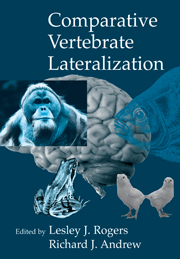Book contents
- Frontmatter
- Contents
- List of Contributors
- Preface
- Introduction
- Part one Evolution of lateralization
- Part two Development of lateralization
- 5 Behavioural development and lateralization
- 6 Factors affecting the development of lateralization in chicks
- 7 Ontogeny of visual asymmetry in pigeons
- 8 Development of laterality and the role of the corpus callosum in rodents and humans
- 9 Posture and laterality in human and non-human primates: Asymmetries in maternal handling and the infant's early motor asymmetries
- Part three Cognition and lateralization
- Part four Lateralization and memory
- Epilogue
- Author Index
- Subject Index
- Richard Andrew
7 - Ontogeny of visual asymmetry in pigeons
Published online by Cambridge University Press: 10 December 2009
- Frontmatter
- Contents
- List of Contributors
- Preface
- Introduction
- Part one Evolution of lateralization
- Part two Development of lateralization
- 5 Behavioural development and lateralization
- 6 Factors affecting the development of lateralization in chicks
- 7 Ontogeny of visual asymmetry in pigeons
- 8 Development of laterality and the role of the corpus callosum in rodents and humans
- 9 Posture and laterality in human and non-human primates: Asymmetries in maternal handling and the infant's early motor asymmetries
- Part three Cognition and lateralization
- Part four Lateralization and memory
- Epilogue
- Author Index
- Subject Index
- Richard Andrew
Summary
Introduction
John Daniel led a life of the upper classes at the end of the British Empire. During parties at his home in 15 Sloane Street, London, he was known for his perfect manners; at 5 o'clock he never missed drinking a cup of tea and after dinner he always asked for a coffee. Apart from that he was known to be right-handed. This aspect of him was, probably, noted by his contemporaries only because John Daniel was not a human being but a gorilla. His life was described by Cunningham (1921), and his brain by LeGros Clark (1927), who discovered a conspicuous asymmetry in the anteroposterior extent of the hemispheres with a larger size on the left side. Of course, LeGros Clark was not able to draw a causal relationship between this morphological asymmetry and John Daniel's handedness.
Since the life and death of John Daniel, we have come a long way in understanding how brains are asymmetrical. We now know that a large number of vertebrate species are lateralized and we are slowly starting to understand that these asymmetries seem to form a coherent pattern, which may indicate that several of the left–right differences observed in the brains of humans and other animals can be traced back to common ancestors (Vallortigara, Rogers and Bisazza, 1999; see also Chapter 1 by Vallortigara and Bisazza).
- Type
- Chapter
- Information
- Comparative Vertebrate Lateralization , pp. 247 - 273Publisher: Cambridge University PressPrint publication year: 2002
- 13
- Cited by



